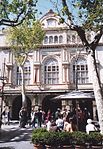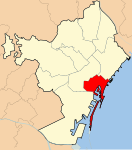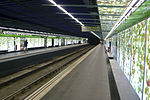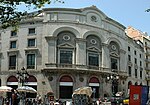Fernando (Barcelona Metro)
Abandoned rapid transit stationsBarcelona Metro stubsCatalan railway station stubsDefunct railway stations in SpainDisused Barcelona Metro stations ... and 2 more
Railway stations closed in 1968Railway stations opened in 1946
Fernando, also called Ferran, is a former Barcelona metro station. The station site is located on line L3 between the existing stations of Liceu and Drassanes, and under the Rambla boulevard.The station opened in 1946 as the terminus of a short extension of L3 from Liceu station. It had a single track and 61-metre (200 ft) long platform, and was accessed by an entrance at the junction of Las Ramblas and Carrer de Ferran. The station was closed in 1968 to permit the extension of the line to Drassanes station.
Excerpt from the Wikipedia article Fernando (Barcelona Metro) (License: CC BY-SA 3.0, Authors).Fernando (Barcelona Metro)
La Rambla, Barcelona
Geographical coordinates (GPS) Address Nearby Places Show on map
Geographical coordinates (GPS)
| Latitude | Longitude |
|---|---|
| N 41.380305555556 ° | E 2.1740277777778 ° |
Address
La Rambla 64
08002 Barcelona (Ciutat Vella)
Catalonia, Spain
Open on Google Maps










